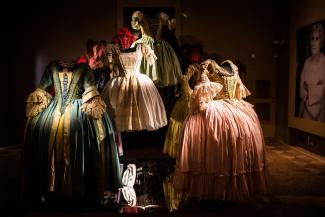
If you had walked across the field to the south of Southwick Road and opposite St Nicholas' Church at Wickham in 1975, no trace of the stately property that once stood there would have been visible to you. Below the ground, however, and waiting for archaeologists to investigate in advance of construction of the Wickham by-pass, lay 800 years of history- of Wickham Manor and its lords and ladies.
The Domesday book records that Hugh De Port held the manor in 1086. He was responsible for the erection of the earliest manor house, timber framed buildings centred on a large aisled hall. The flint footings and postholes discovered by the archaeologists revealed some of the ground plan of this building, and the hearth in the great hall still survived as close-packed tiles set on edge in the ground.
By the time that the right to hold markets in Wickham was granted by Henry III in 1268, the manor had passed to the de Scures, who refurbished and extended it in the latest style, and who built in stone. The new walls were mainly of flint with limestone dressings around the doors, windows and gables. At this time, a moat was also constructed and the river Meon was dammed to form fishponds.
In 1381, the Uvedale family acquired the manor through marriage. During their tenure of over 300 years, they first effected a series of repairs and alterations to the medieval buildings, installing chimneys to replace the central hearth, and better sanitation in the form of a well-built garderobe (toilet). Following this, with the rise to popularity of the new building medium, brick, the old house was demolished in the mid 17th century to make way for a rectangular gable-ended manor with three bays.
The Garniers were the last owners of the manor. It was sold to them in 1764 by the Rashleighs, who, having bought it when the Uvedale line died out, had spent the previous 40 years adding substantial new wings, so that the building eventually formed three sides around an open area. A document relating to the sale lists: a mansion house; orchards; gardens; brewhouses; fishponds; watercourses, pieces or parcels of land, three roads… reminding us that Wickham Manor was not just a house but a whole estate. In 1835, though, the Garniers moved to a new house, Rookesbury, and Wickham Manor house was dismantled so that its building materials could be used for other purposes. By the middle of the 19th century, the whole site had reverted to the fields that you would have seen in 1975.
From the time of Hugh de Port onwards, the families who owned Wickham manor included members who served as Sheriffs of Hampshire. This high social standing, and the new wealth brought to the community when market rights were granted to Roger de Scures by king Henry is reflected in the site's archaeology. The high quality of the building materials still remaining in the ground, especially those recovered from the late 13th century manor house, and the rarity and value of some of the more portable objects or archaeological 'finds' shown on this website illustrate such social eminence.


